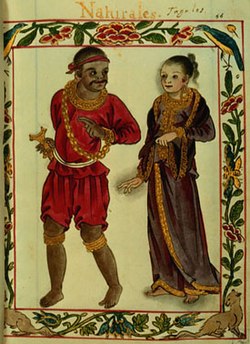In early Philippine history, the rank of lakan denoted a "paramount ruler" (or more specifically, "paramount datu") of one of the large coastal barangays (known as a "bayan") on the central and southern regions of the island of Luzon.[1]

Overview
editThe lakan was democratically selected by other ruling datus from among themselves to serve as their "pangulo" (head).[2] Writers such as William Henry Scott have suggested that this rank is equivalent to that of rajah, and that different ethnic groups either used one term or the other, or used the two words interchangeably.[3][4] But other writers such as Nick Joaquin have suggested that the usage of the term "rajah" specifically indicates leadership of a bayan or barangay which has extensive trade relations with Muslim traders.[2][5] Equivalent terms for this rank include the term "sultan" in the Muslim polities of Mindanao, and the term "datu" as used by various polities in the Visayas and in some areas of Mindanao.[6]
Orthography
editThere is no particular legal or academic prescription of orthography for the title of lakan. Thus it may be spelled separate from the person's name (e.g. "Lakan Dula"), or be incorporated with the name to form a single word (e.g. "Lakandula").
Rajah and lakan: It is sometimes argued that since the titles "rajah" and "lakan" are roughly equivalent, the two should not be used together. Thus, referring to Lakandula as Rajah Lakandula is said to be the result of mistaking Lakandula to be the full proper name of the said king.[4]
Prominent lakans
editUsers of the title lakan that figure in 16th- and 17th-century Spanish colonial accounts of Philippine history include:
- Lakandula (later christened as Don Carlos Lacandola), ruler of Tondo when the Spanish conquest of Luzon began.
- Lakan Tagkan, ruler of Namayan.[citation needed]
- Lambusan (Lakan Busan), a king in pre-colonial Mandaue.[citation needed]
- Lakan Usman, king of Bangsa Usman.[citation needed]
Present-day usage
editIn present-day culture, the term is still occasionally used to mean "nobleman", but has mostly been adapted to other uses.
The name of Malacañan Palace, the official residence of the president of the Republic of the Philippines, is traditionally attributed to the phrase may lakan diyan, or "the king [or head] resides there".[7]
In Filipino Martial Arts, lakan denotes an equivalent to the black belt rank.[8] Also, beauty contests in the Philippines have taken to referring to the winner as "lakambini", the female equivalent of lakan. In such cases, the contestant's assigned escort can be referred to as a lakan. More often, a male pageant winner is named a lakan.[9]
Philippine National Police Academy graduates are called lakan (male) and lakambini (female)
See also
editSources
edit- ^ "Pre-colonial Manila". Malacañang Presidential Museum and Library. Malacañang Presidential Museum and Library Araw ng Maynila Briefers. Presidential Communications Development and Strategic Planning Office. 23 June 2015. Archived from the original on 9 March 2016. Retrieved 27 April 2017.
- ^ a b Jocano, F. Landa (2001). Filipino Prehistory: Rediscovering Precolonial Heritage. Quezon City: Punlad Research House, Inc. ISBN 971-622-006-5.
- ^ Scott, William Henry, Barangay: Sixteenth-Century Philippine Culture and Society, Quezon City: Ateneo de Manila University Press, 1994.
- ^ a b Laput, Ernesto J. (2004-08-16). "PINAS: Buhay Sa Nayon". Mga Kasaysayan Ng PINAS: A Web of Philippine Histories. Archived from the original on 2004-08-16. Retrieved 2017-06-29.(in Tagalog)
- ^ Joaquin, Nick (1990). Manila, My Manila: A History for the Young. City of Manila: Anvil Publishing, Inc. ISBN 978-971-569-313-4.
- ^ Junker, Laura Lee (1998). "Integrating History and Archaeology in the Study of Contact Period Philippine Chiefdoms". International Journal of Historical Archaeology. 2 (4): 291–320. doi:10.1023/A:1022611908759. S2CID 141415414.
- ^ Ocampo, Ambeth (1995). "Inside Malacañang". Bonifacio's Bolo. Pasig: Anvil Publishing Inc. p. 122. ISBN 971-27-0418-1.
- ^ "Lakan Definition". martialedge.net.[permanent dead link]
- ^ "Art & Culture". oroquietacity.com. 1 May 2013. Archived from the original on 17 April 2017. Retrieved 19 May 2023.